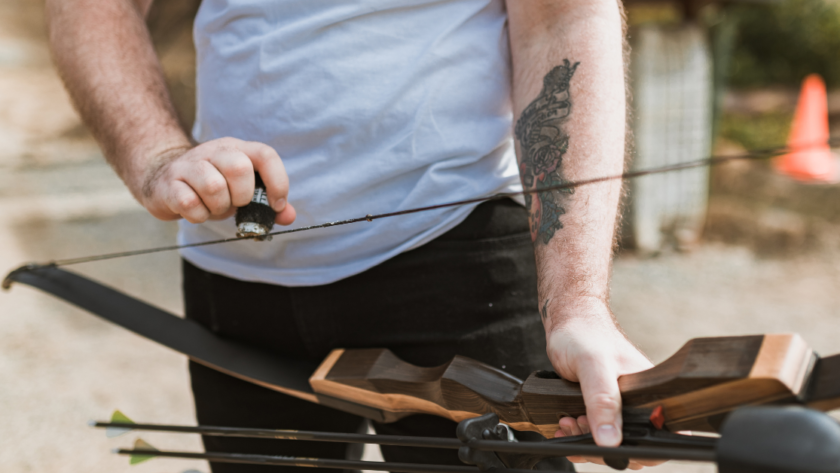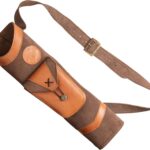As an avid archer, I’ve learned that success often hinges on the smallest details. One of the most overlooked yet crucial elements in archery is bow string wax.
This simple substance plays a vital role in maintaining your equipment and enhancing your performance.
The Importance of Bow String Wax
Bow string wax serves multiple purposes, all of which contribute to the longevity and performance of your bow:
Protection Against Wear and Tear
Every time you draw your bow, the string fibers rub against each other. This friction can lead to fraying and weakening over time.
Wax acts as a lubricant, allowing the fibers to slide smoothly past each other, significantly reducing wear and tear.
Moisture Resistance
Moisture is the enemy of bow strings. It can seep into the fibers, causing them to swell and potentially weaken.
A good layer of wax creates a barrier that helps repel water, keeping your string dry and maintaining it’s integrity.
UV Protection
Sunlight can be surprisingly damaging to bow strings. UV rays can break down the fibers over time, leading to premature aging and potential failure.
Many modern waxes include UV inhibitors to help protect against this invisible threat.
Vibration Dampening
A well-waxed string tends to vibrate less after release, which can contribute to a quieter shot. This is particularly important for bowhunters who need to minimize noise to avoid spooking game.
Consistency in Performance
By maintaining the string’s condition, wax helps confirm consistent performance shot after shot. This consistency is crucial for accuracy and can make a significant difference in both target archery and hunting scenarios.
Types of Bow String Wax
There are several types of bow string wax available, each with it’s own characteristics:
Natural Waxes
Beeswax is the most common natural wax used for bow strings. It’s been used for centuries and stays popular among traditional archers.
Beeswax offers good protection and has a pleasant scent, but it can be less durable than synthetic options.
Synthetic Waxes
Modern synthetic waxes are formulated specifically for archery use. They often include additives for enhanced protection and can be tailored for different string materials.
Synthetic waxes typically offer more consistent performance across a range of temperatures.
Hybrid Waxes
Some manufacturers combine natural and synthetic ingredients to create hybrid waxes. These aim to offer the best of both worlds, with the natural feel of beeswax and the enhanced protection of synthetic formulations.
How to Apply Bow String Wax
Proper application of bow string wax is crucial for most benefit. Here’s a step-by-step guide:
- Clean the String: Use a clean, dry cloth to remove any dirt or debris from the string.
- Apply the Wax: Run the wax along the length of the string, applying a thin, even layer.
Avoid the serving areas (the wrapped sections at the ends of the string and around the nocking point).
- Work It In: Use your fingers or a piece of leather to work the wax into the string fibers.
The friction will warm the wax, helping it penetrate deeper.
- Remove Excess: Wipe away any excess wax with a clean cloth.
Too much wax can attract dirt and grime.
- Inspect and Repeat: Check the string for any missed spots and reapply as needed.
For best results, wax your string when it’s at room temperature. In cold weather, you might need to warm the wax slightly before application to confirm it penetrates effectively.
When to Wax Your Bow String
The frequency of waxing depends on several factors:
- Usage: The more you shoot, the more often you’ll need to wax.
- Climate: Harsh weather conditions may necessitate more frequent waxing.
- String Material: Some materials need more frequent waxing than others.
As a general rule, inspect your string before each shooting session. If it looks dry or fuzzy, it’s time for a wax.
For most archers, this translates to waxing every few weeks to once a month.
The Risks of Over-Waxing
While regular waxing is important, it’s possible to overdo it. Too much wax can:
- Attract dirt and debris
- Interfere with arrow release
- Potentially affect arrow speed
If you notice a buildup of wax on your string, it’s time to clean it off and start fresh.
Specialized Waxes for Specific Needs
As archery technology advances, so do the options for string wax:
Scent-Free Waxes for Hunting
Bowhunters often prefer scent-free waxes to avoid alerting game to their presence. Some waxes even incorporate scent-blocking technology.
Color-Preserving Waxes
For archers who use multi-colored strings for quick nocking reference, there are waxes designed to help maintain string color vibrancy.
Temperature-Specific Waxes
If you shoot in extreme conditions, look for waxes formulated to maintain their protective properties in high heat or freezing cold.
DIY Bow String Wax
While commercial waxes are readily available, some archers prefer to make their own. A simple recipe involves melting equal parts beeswax and pine rosin, with a small amount of anhydrous lanolin added for extra moisture protection.
However, homemade waxes may not offer the same level of protection as modern commercial formulations.
The Science Behind Bow String Wax
Modern bow string waxes are carefully engineered products. They’re designed with specific melting points, usually around 140-160°F (60-71°C), to confirm they stay put during normal use but can be worked into the string fibers with friction.
The molecular structure of these waxes allows them to penetrate the string fibers, coating each person strand for most protection. Some waxes include nanoparticles that bond at a molecular level with the string material, providing unparalleled protection and longevity.
Bow String Wax and Different Bow Types
While the basic principles of waxing stay the same, different bow types may have specific needs:
Compound Bows
Compound bows often use modern synthetic strings that benefit from specialized synthetic waxes. Pay extra attention to the areas around the cams, as these experience the most wear.
Recurve Bows
Traditional recurve bows, especially those used in Olympic-style archery, often use Dacron strings that respond well to both natural and synthetic waxes.
Traditional Longbows
Archers using traditional longbows often prefer natural waxes like beeswax, which aligns with the traditional nature of their equipment.
Bow String Wax and String Materials
Different string materials may benefit from specific types of wax:
Fast Flight and Similar Materials
These modern, high-performance string materials often benefit from synthetic waxes designed to withstand high temperatures and friction.
Dacron
This more traditional string material works well with both natural and synthetic waxes.
Flemish Twist Strings
These traditional strings, often used on longbows, typically respond well to natural waxes like beeswax.
Environmental Considerations
As environmental awareness grows, some archers are looking for eco-friendly wax options. Biodegradable waxes made from plant-based ingredients are becoming more common.
These offer good protection while minimizing environmental impact.
Wax and Bow Tuning
A well-waxed string can play a role in bow tuning:
- It helps maintain consistent string tension, which affects draw weight and arrow speed.
- It can help keep the peep sight aligned properly.
- It contributes to overall bow efficiency by reducing energy loss through friction.
Storing Your Bow String Wax
Proper storage of your wax is important:
- Keep it in a cool, dry place.
- Avoid leaving it in direct sunlight or extreme temperatures.
- Some archers prefer to keep their wax in a small, sealable container for easy transport to the range or field.
Removing Old Wax
Occasionally, you may need to remove old wax buildup:
- Use a clean, dry cloth to wipe away as much old wax as possible.
- For stubborn buildup, use a string cleaner or a small amount of rubbing alcohol on a cloth.
- Allow the string to dry completely before applying new wax.
Wax and String Longevity
Regular waxing significantly extends the life of your bow string. A well-maintained string can last for thousands of shots, while a neglected you might need replacement after just a few hundred.
Competition Considerations
For competitive archers, string wax can be a crucial factor:
- Some competitions have rules about the types of wax allowed.
- Consistent waxing practices can contribute to more predictable performance.
- In long tournaments, re-waxing between rounds may be necessary to maintain optimal performance.
Wax Application Tools
While fingers work well for applying wax, some archers prefer specialized tools:
- String servers: These tools help work the wax into the string fibers evenly.
- Wax applicators: Some waxes come with built-in applicators for easy use.
- Heat guns: Used very carefully, these can help the wax penetrate deeper into the string fibers.
The Future of Bow String Wax
As archery technology continues to advance, we’re seeing exciting developments in string wax:
- Nano-technology enhanced waxes for superior protection
- Smart waxes that change properties based on temperature
- Waxes with built-in string condition indicators
Common Mistakes in Waxing
Avoid these common pitfalls:
- Over-waxing, which can attract dirt and affect performance
- Under-waxing, leaving the string vulnerable to damage
- Waxing the serving areas, which can interfere with arrow nocking and release
- Using the wrong type of wax for your string material
Wax and Bow Sound
A well-waxed string can contribute to a quieter shot, which is particularly important for bowhunters. The wax helps dampen string vibration, reducing noise upon release.
Wax and Arrow Speed
While the effect is minimal, a properly waxed string can contribute to slightly faster arrow speeds by reducing friction and ensuring effective energy transfer.
Seasonal Waxing Considerations
Your waxing routine may need to change with the seasons:
- In hot weather, you might need to wax more often as the wax can melt and wear off faster.
- In cold weather, warming the wax slightly before application can help it penetrate the string fibers more effectively.
- In wet conditions, pay extra attention to waxing to protect against moisture.
Wax and Bow Storage
If you’re storing your bow for an extended period:
- Apply a fresh coat of wax before storage.
- Store the bow in a cool, dry place to prevent the wax from melting or attracting dust.
- When you’re ready to use the bow again, inspect the string and re-wax if necessary.
Wax and String Color
Some archers use colored strings for quick nocking point reference or simply for aesthetics. Regular waxing can help preserve string color, especially if you use a wax designed for color retention.
Wax and String Stretch
While wax doesn’t directly prevent string stretch, it does contribute to overall string health, which can minimize stretching over time.
Wax and Peep Sight Alignment
A well-maintained, properly waxed string is less likely to twist, helping to keep your peep sight properly aligned shot after shot.
Key Takeaways
- Regular waxing is crucial for string longevity and performance.
- Choose a wax that suits your shooting style, bow type, and environment.
- Apply wax sparingly and work it into the string fibers thoroughly.
- Inspect your string regularly and wax as needed.
- Be aware of the specific needs of your bow type and string material.
- Don’t overlook this simple maintenance step – it could make a significant difference in your archery experience.
People Also Asked
How often should I wax my bow string?
Most archers should wax their bow string every few weeks to once a month, depending on usage and environmental conditions. Inspect your string before each shooting session and wax if it appears dry or fuzzy.
Can I use candle wax on my bow string?
It’s not recommended to use candle wax on your bow string. Candle wax isn’t formulated for the specific needs of archery and may not provide adequate protection.
Stick to waxes designed specifically for bow strings.
Does string wax affect arrow speed?
String wax can have a minor impact on arrow speed. A properly waxed string reduces friction, potentially leading to slightly faster arrow speeds. However, over-waxing can have the opposite effect by adding unnecessary weight to the string.
How do I remove old wax from my bow string?
To remove old wax, first wipe the string with a clean, dry cloth. For stubborn buildup, use a dedicated string cleaner or a small amount of rubbing alcohol on a cloth.
Allow the string to dry completely before applying new wax.
Is beeswax good for bow strings?
Beeswax can be effective for bow strings, especially for traditional bows. It offers good protection and has a pleasant scent.
However, modern synthetic waxes often provide superior protection and consistency, especially for compound bows.
Can I make my own bow string wax?
Yes, you can make your own bow string wax. A common DIY recipe involves melting equal parts beeswax and pine rosin, with a small amount of anhydrous lanolin added. However, commercial waxes are often formulated to provide better protection and performance.
Does waxing help silence a bow?
Yes, proper waxing can help silence a bow. The wax helps dampen string vibration, reducing noise upon release.
This is particularly useful for bowhunters who need to minimize noise.
How does climate affect bow string waxing?
Climate significantly affects bow string waxing. In hot weather, wax may melt faster, requiring more frequent application.
In cold weather, wax may become stiff, necessitating warming before application.
Humid conditions may need more frequent waxing to protect against moisture.
Can over-waxing damage my bow string?
While over-waxing typically won’t damage the string itself, it can attract dirt and debris, potentially leading to increased wear. Excessive wax can also interfere with arrow release and potentially affect arrow speed.
Is there a difference between compound and recurve bow string wax?
While many waxes work for both compound and recurve bows, some are formulated specifically for certain string materials or bow types. Compound bows often benefit from modern synthetic waxes, while traditional recurve archers might prefer natural waxes like beeswax.


